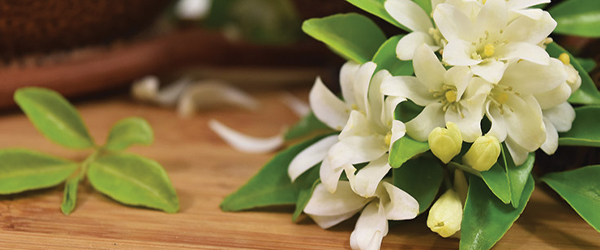During a rainy summer like the one we’re experiencing, it’s nice to have a little colour inside your home to balance out the gray skies.
These 5 flowering plants will continue to reward you with colourful blooms and tasteful aromas.
While it will take a little bit of work to get the most out of the flowers, the extra bit of joy that they’ll provide to your every day life will be well worth the effort.
Jasmine (J. polyanthum)
Common names: Jasmine, Chinese jasmine, and winterblooming jasmine

Sunlight: Bright, with up to 4 hours of direct sunlight late spring through fall. Decrease direct sunlight in winter.
Soil: Porous, modified with bark, coir, or other organic material. Ensure good drainage.
Water: Keep soil moist, but never soggy.
Fertilizer: Use a weakened houseplant food throughout the growing season.
A busy climber with beautiful white blooms, this Jasmine plant takes a bit of work, but rewards gardeners with a lovely fragrance.
During the summer, place your Jasmine plant in a partially sunny spot outdoors from time to time to encourage growth.
When autumn comes, place the plant outdoors once again for a six week stint in order to encourage buds to form. Without these cooler temperatures later in the season, your Jasmine may not bloom at all.
Inside, make sure your Jasmine is near a south window where it can get lots of light, and have a trellis nearby to allow the plant to climb.
African Violet

Sunlight: Medium to bright indirect light
Soil: Loose, well drained, and high in organic content.
Water: Do not over water. Use tepid or room temperature water to ensure the soil is moist but not saturated.
Fertilizer: Use a commercial African Violet food to ensure proper fertilization.
African Violet’s are a lovely little houseplant with fuzzy green leaves that produces a cluster of purple, blue, or white flowers in it’s centre.
The flowers have such a following that there’s even an entire society dedicated to them. Learn more about them at www.avsa.org
While they can be a bit fussy to ensure consistent blooms, there’s no shortage of information online to help you get the most out of your violets.
Christmas Cactus

Sunlight: Bright, indirect light
Soil: Slightly sandy soil that drains well. Most container soils will work.
Water: Water frequently, allowing the top inch of soil to dry before thoroughly re-watering. Ensure good drainage and discard excess water so the roots are never submerged.
Fertilizer: A mild houseplant fertilizer solution an be applied every other week.
The Christmas Cactus provides a joyous splash of colour with its bright pink blossoms and green stems. While this is a cactus, its natural habitat is in the rain forests of Brazil, as a result it prefers a more humid environment.
These cactus are relatively easy to maintain, but will take a little more work if you want to ensure a good crop of budding flowers. You’ll also have to keep your eye out to make sure you’ve purchased a Christmas Cactus, as the Thanksgiving and Easter Cactus also exist, which are similar, but have differently shaped leaves.
Crown of Thorns

Sunlight: Three to four hours of direct sunlight per day.
Soil: A well-draining potting mix.
Water: Water once the soil is dry to an inch below the surface. Water thoroughly and then remove any excess collected in the dish below.
Fertilizer: Use a liquid houseplant fertilizer bi-weekly. In winter, dilute the fertilizer to half strength and apply monthly.
The Crown of Thorns makes a good houseplant because it thrives in room temperature and can handle the dry air of a home. While there are sharp black thorns along the main stem of the plant, these are easily avoided and not much hassle unless the plant is being re-potted.
Hybridizers have continued to tweak this plant over the past decade to increase flower sizes and add new colours to the blooms. In the right conditions, these flowers can bloom all year round.
Moth Orchids

Sunlight: Strong light. Indirect light in the afternoon.
Soil: Orchids tend to come potted and flowering. When repotting, use an orchid potting mixture, typically composed of chunky elements that allow for good drainage.
Water: In the summer, water weekly and heavily, allowing to soak then dry afterwards. In winter, water monthly.
Fertilizer: Use a weak solution of liquid houseplant fertilizer on a weekly basis.
The delicate and colourful flowers of the Orchid family are a beautiful addition to any room. These days, inexpensive Orchids are easy enough to obtain from your local grocery store, usually when they’re already in full bloom. But, with a little bit of work you can ensure annual blooms that will brighten your mood and leave you pleased that you persevered.
Once the blooms have fallen off of your orchid, trim the now dead flower spike and re-pot the plant using an orchid soil mixture and an orchid pot. The roots of the orchid don’t absorb nutrients from the soil, but instead quickly absorb water and allow the plant to breathe, hence the necessity for a chunky and loose soil.
Live Colourfully
While these 5 flowering house plants will make an excellent addition to your home, there are plenty more out there that can add colour to your home.
Start with these 5 options, and grow your green thumb from there.



